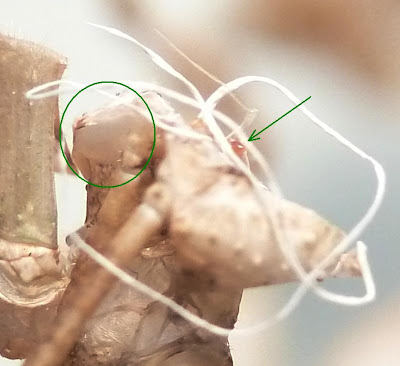In invertebrates such as stick insects there is an incomplete metamorphosis with a series of nymphs (instars) that gradually increase in size but are approximately the same overall form as the adult. During each instar, the next larger 'skin' is grown wrinkled inside the existing one - when ready, hormonal effects detach the skin layers from each other and the old one splits along predefined lines of weakness. The next instar can then emerge, leaving an empty skin or 'exuvium'. This contrasts with groups that show complete metamorphosis where the larva develops into a pupa before emerging as an adult (imago) with a very different appearance - the most well known example of this is probably the butterflies.
In E. tiaratum, the soon-to-moult nymph clings to foliage or twigs with its legs, and the old skin splits lengthways along the dorsal midline of the thorax starting at the back of the head. The insect then pulls its front half free and leans backwards through this split, hanging by its still attached abdomen - the whole process takes from 30 minutes to two hours (Brock, 2000).
 |
| Final instar female E. tiaratum moulting. |
The picture above shows that the rear left leg is very small - this is due to a leg being lost during a previous moult. This highlights the risks associated with moulting and in this case was due to the old and new skins not separating around this leg. Having watched the otherwise fully moulted insect attempting to remove the still-attched skin for some time, I was forced to intervene and the leg was removed. However the loss of one (or even two or three) legs does not unduly affect the insect (in the wild it is a useful way to escape predators who are left with just a single twitching leg). Lost legs do regrow to some extent with successive moults but as seen here are smaller, starting as a thin black stump after one moult. Interestingly, research on another stick insect species (Sipyloidea sipylus) indicates that regrowing legs reduces adult wing size and hence flight performance, showing that there is a trade-off between development of legs and wings due to limited total resources for appendage growth and that this may have affected the evolution of this group (Maginnis, 2006) which has lost and regained wings on a number of occasions throughout its evolutionary history.
Usually, the old skin is eaten as the first post-moult meal, but occasionally it is lost (e.g. if it falls from its point of attachment) and subsequently ignored. I have also seen larger specimens eating the shed skin of another recently moulted individual. However, when a skin remains uneaten it is a useful way of investigating the finer structure of these insects and the moulting process.
 |
| A whole moulted skin of a male E. tiaratum showing the long wing-buds. This is approximately 40mm long although the curled abdomen means the insect was around 60mm long prior to moulting. |
 |
| The dorsal split through which the insect emerged during moulting. The air tubes are clearly visible here including their points of attachment at the spiracles. |
 |
| The moulted head of E. tiaratum showing the surfaces of both types of eye. |
References
Brock, P.D. (2000). A Complete Guide to Breeding Stick and Leaf Insects. Kingdom, Havant.
Maginnis, T.L. (2006). Leg regeneration stunts wing growth and hinders flight performance in a stick insect (Sipyloidea sipylus). Proceedings. Biological sciences / The Royal Society 273(1595): 1811-1814.
Good indepth article. One of my females had issues with her molt and is trapped within the old exoskeleton. I managed to free her sides so she can breathe and now, two weeks later she's still hanging on. She looks terrible but I'm feeding her by hand via a pipette as she can't seem to eat leaves. I'm hoping she'll make it to the next molt but only time will tell.
ReplyDelete